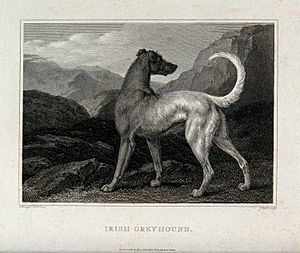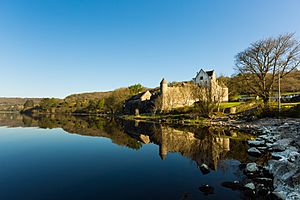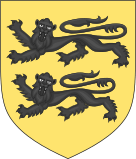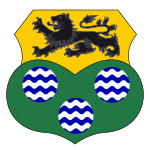Brian O'Rourke facts for kids
Quick facts for kids Sir Brian O'Rourke(Sir Brian na Múrtha Ó Ruairc) |
|
|---|---|
| King (Lord) of West Breifne | |
| Reign | 1566-1591 |
| Predecessor | Aodh Buidhe Ó Ruairc |
| Successor | Brian Oge O'Rourke |
| Born | c. 1540 West Breifne, Ireland |
| Died | 3 November 1591 (aged 50–51) Tyburn, England |
| Consort | Annalby O'Crean Mary Burke (sep. before 1585) Elenora Fitzgerald (d. 1589) |
| Issue | Eóghan (d. 1589) Brian Óg (d.1604) Tadhg (d. 1605) Art Eogan Mary |
| House | O'Rourkes of Dromahair |
| Father | Brian Ballagh Ó Ruairc |
| Mother | Grainne Ní Catháin |
| Religion | Roman Catholicism |
Sir Brian O'Rourke (Irish: Sir Brian na Múrtha Ó Ruairc; around 1540 – 1591) was a powerful leader in Ireland. He was the king, and later lord, of West Breifne from 1566 until 1591. His rule happened during the time when England, under the Tudor dynasty, was trying to take more control over Ireland.
Even though the English made him a knight in 1585, they later called him a rebel. He had to leave his kingdom in 1590. Brian O'Rourke went to Scotland in 1591 to ask for help from King James VI. However, he was sent back to England. This was the first time someone was officially sent from one part of Britain to another because of crimes said to be committed in Ireland. He was sentenced to death in London in November 1591.
Contents
Brian O'Rourke's Early Life
Brian O'Rourke belonged to one of the most important families in Gaelic Ireland. People said he was handsome and very smart for a Gaelic lord. He became the leader of his family in the mid-1560s. His land, West Bréifne, was near the border of Ulster. It soon came under the control of the English government's new area called the Presidency of Connacht.
His main territory was around Lough Gill and Dromahair. Today, you can still see the old foundations of his family's tower house at Parke's Castle. This castle is close to Dromahair.
The English leaders found Brian O'Rourke to be a very proud man. In 1575, Sir Henry Sidney, an English official, said O'Rourke was the proudest person he had ever met in Ireland. Another official, Sir Nicholas Malby, also called him "the proudest man this day living on the earth."
Dealing with English Control
Brian O'Rourke was willing to work with the English government at times. In 1577, he made an agreement with Malby. In this agreement, he recognized Queen Elizabeth I as the ruler of Ireland.
But his loyalty was questioned a few years later. During the Second Desmond Rebellion in Munster, he rebelled against the English rule in Connacht. The English thought he was working with the Dillon family, who wanted to expand their lands.
In 1584, Sir Richard Bingham became the new head of Connacht. O'Rourke quickly complained that Bingham was bothering him. Bingham was told by his boss in Dublin Castle to be patient and not go into O'Rourke's land. Even though O'Rourke's land was part of Connacht, it didn't have an English sheriff. O'Rourke liked keeping his freedom.
He still kept ties with the government in Dublin. He even went to the opening of parliament in 1585. People noticed he wore all black and was with his very beautiful wife.
To prepare for the Composition of Connacht, an agreement where lords would formalize their land ownership with the government, O'Rourke gave up his lordship in 1585. He was supposed to get his lands back under a new agreement. This meant he would give a special horse and a gold token to the English leader every year. It seemed like a fair deal, but O'Rourke never fully accepted the official papers and didn't see the terms as binding.
By 1586, the tension with Bingham grew. O'Rourke made complaints against Bingham to the council in Dublin, but they were dismissed. Bingham believed that another official, Sir John Perrot, was behind these complaints. When Bingham left for a short time in 1587, Perrot lowered O'Rourke's yearly payments and even let him collect some illegal taxes. Perrot also made O'Rourke the sheriff of Leitrim for two years.
Brian O'Rourke's Rebellion
O'Rourke was still unhappy with England interfering in his lands. He was also proud to be known as a leading Catholic lord. After Perrot left, O'Rourke helped at least eighty survivors of the Spanish Armada leave Ireland in 1588. He was seen as someone who would welcome Spanish forces in the future. Even though he wasn't officially called a rebel, he strongly resisted Bingham's forces and would not be controlled.
O'Rourke's demands against the government grew as violence increased near his lands. In peace talks in 1589, he agreed to pay a tribute that his grandfather had agreed to. But he refused the land agreement from 1585. He also would not let the English government set up their own administration in the new county of Leitrim.
Instead, he wanted to be appointed as a seneschal, which would mean he reported directly to the Dublin government, keeping him independent from Bingham. He also wanted to be sure he would keep his lands, be safe for life, and that merchants coming into his territory would not be bothered by English forces. In return, he only offered his word. An official from Dublin advised him not to come in, hinting he would be arrested. So, O'Rourke refused the government's offers.
Flight and Capture

Under the new English leader, Sir William Fitzwilliam, pressure increased on the lands near Ulster. In the spring of 1590, Bingham's forces took over West Breifne, and O'Rourke had to flee. Later that year, the nearby land of Monaghan was also taken by the English after its lord was executed.
O'Rourke arrived in Scotland in February 1591. He brought "six beautiful Irish horses and four large dogs" as gifts for the Scottish king. He was looking for a safe place to stay and also wanted to hire soldiers to fight for his lands.
However, King James VI of Scotland did not meet with him. Queen Elizabeth of England strongly asked for O'Rourke to be handed over to her. This was based on a treaty between England and Scotland.
The matter went to the Scottish privy council. They quickly ordered O'Rourke's arrest and delivery to English forces, despite some objections. Elizabeth's advisors had hinted that O'Rourke might be treated kindly, and some Scottish officials agreed to send him, hoping his life would be spared. This hope was not met.
O'Rourke was arrested in Glasgow. The people of Glasgow tried to stop him from being handed over, fearing it would hurt their trade with Ireland. Their request was denied, causing a public outcry. The king's officers were called "Queen Elizabeth's knights," and people said the Scottish king had been paid off by the English. O'Rourke had debts, and his creditors worried they wouldn't be paid. The English ambassador paid £47 to help. O'Rourke was taken from Glasgow on April 3, 1591, during a riot. Two ships on the west coast were looted, and guards had to be placed on all ships sailing to Ireland.
Trial and Execution
O'Rourke was taken to the Tower of London. He was held there while legal arguments began. Even though treason trials in the Tudor period were often more about politics than justice, the outcome was not certain. There was a serious question about whether O'Rourke could be tried in England for treason committed in Ireland. The judges gave a mixed opinion, saying the trial could go ahead under an old treason law from King Henry VIII.
Meanwhile, charges were made against O'Rourke in Dublin, with help from Bingham. There was also an official accusation from a jury in Sligo. These matters were sent to England. A jury in Middlesex found evidence of several acts of treason. The most important charges were helping the Armada survivors, trying to hire soldiers in Scotland, and leading armed raids into counties Sligo and Roscommon.
There was also a strange charge from 1589. It was said that a picture or carving of the Queen was tied to a horse's tail at O'Rourke's command and dragged in the mud. This was called the treason of the image. However, some people think it was just an old New Year's tradition that was misunderstood to make the charges stronger.
O'Rourke was brought to court on October 28, 1591. The charges were translated into Irish for him. One person said he refused to enter a plea, but official records state that a plea of "not guilty" was entered. He was asked how he wanted to be tried. He said he would agree to a jury trial if he had a week to look at the evidence, a good lawyer, and if the Queen herself was the judge. The judge refused these requests and said the jury would try him anyway. O'Rourke replied, "If they thought good, let it be so." The trial went ahead, and O'Rourke was found guilty and sentenced to death.
On November 3, 1591, O'Rourke was taken to Tyburn for his execution. On the scaffold, Miler Magrath, an archbishop, asked O'Rourke to repent for his sins. O'Rourke insulted him, questioning his faith and calling him a bad person who had broken his vows. O'Rourke was then executed by hanging and quartering.
The writer Francis Bacon mentioned an Irish rebel who was hanged in London and asked to be executed with a willow branch instead of a rope. It is likely he was talking about Brian O'Rourke.
Brian O'Rourke's Legacy
Brian O'Rourke's story as a rebellious Irish lord is important. What makes it special is how he was brought down. First, there was the English campaign to put pressure on the lands near Ulster. Then, the Scottish king worked with the English. This led to the first time someone was officially sent from one part of Britain to another for a trial.
Evidence from O'Rourke's treason trial was later used in the trial of John Perrot. The English then pursued a more aggressive policy against the lords of Ulster. This led to the start of the Nine Years War. O'Rourke was caught up in the big changes happening as a new political system was being formed in Britain, which King James VI would lead as the first monarch just over ten years later.
O'Rourke remains an important figure in the fight of Irish lords against English expansion in the 1500s. He was an early example for the next generation of Irish nobles who would fight the English in the Nine Years War. This war marked the end of the old Gaelic way of life in Ireland.
The surname O'Rourke is still one of the most common surnames in County Leitrim today. To honor the history of the kings of West Breifne, the county's coat of arms features a modified version of the O'Rourke family crest.
Brian O'Rourke's Family
Brian O'Rourke had at least six known children: Eóghan, Brian Óg, Tadhg, Art, Eogan, and Mary.
His first two children, Eóghan (born 1562) and Brian Óg (born 1568), were with Annalby O'Crean. She was described as the wife of a merchant, and it's not known if she and Brian were officially married.
Brian's first recorded marriage was to Lady Mary Burke. She was the daughter of the second Earl of Clanricarde. They had three known children: Tadhg (born 1576), and two other sons named Art and Eogan. O'Rourke and Burke separated before 1585 but never officially divorced. Tadhg, and possibly their other children, continued to live with their mother after the separation.
O'Rourke later married Elenora, the daughter of James FitzGerald, 14th Earl of Desmond. They had a daughter named Mary, who married Sir Hugh O'Conor, O'Conor Don. Elenora and Brian later separated, and she remarried. She died in the spring of 1589. Based on accounts from Francisco de Cuellar, who stayed at O'Rourke's castle in 1588, Brian seems to have married again. De Cuellar described this wife as "beautiful in the extreme."




